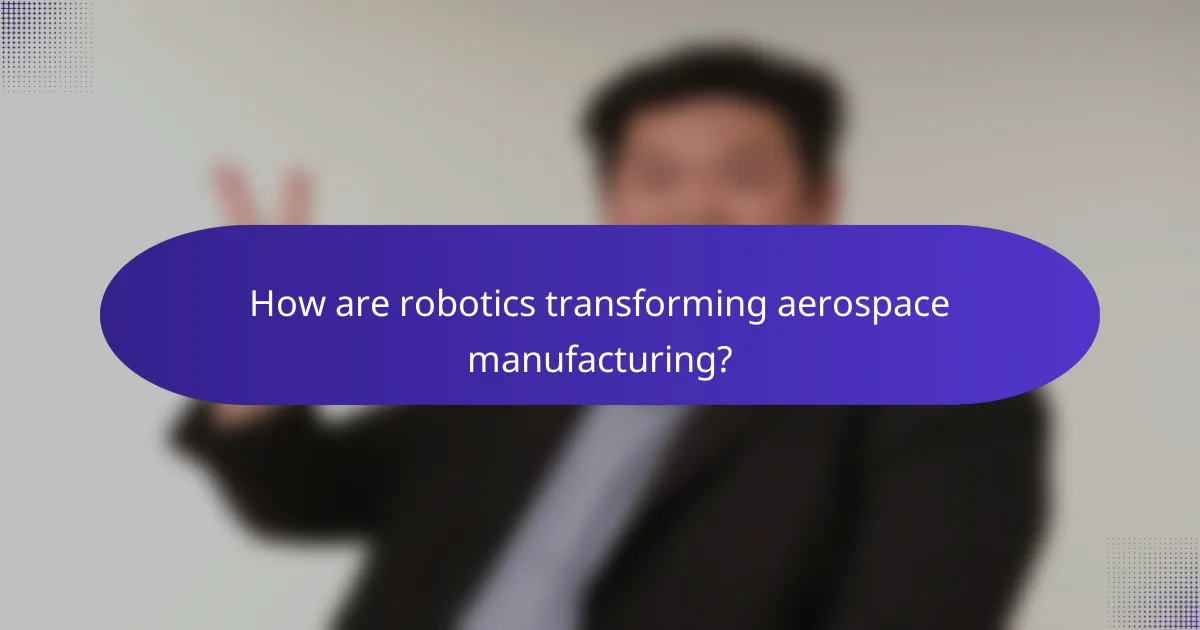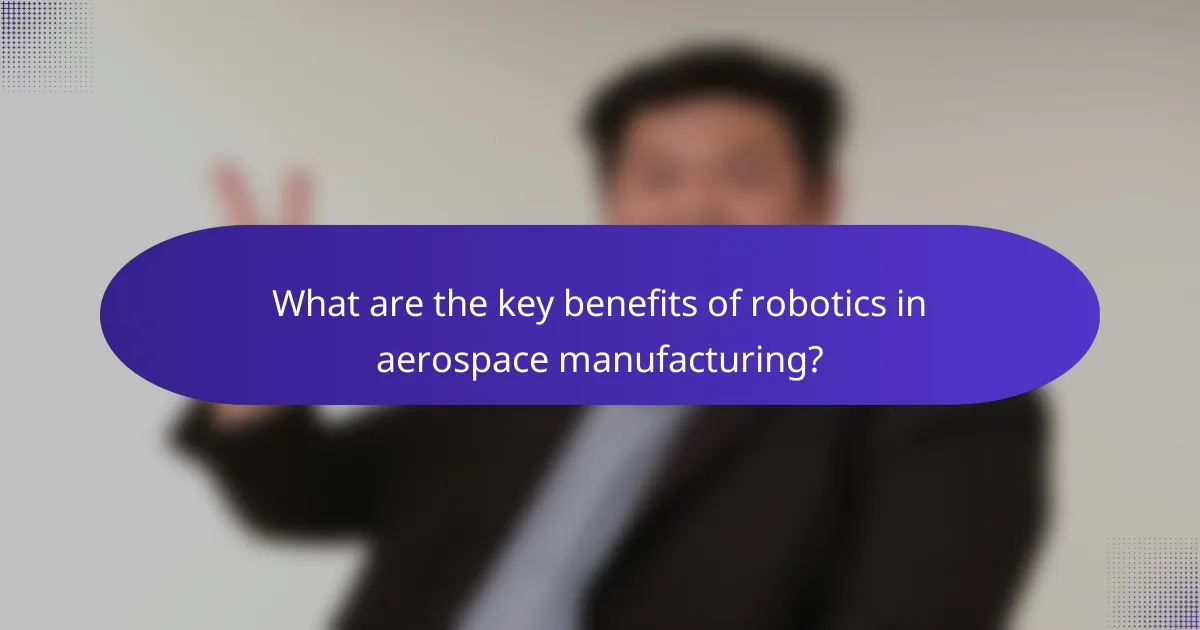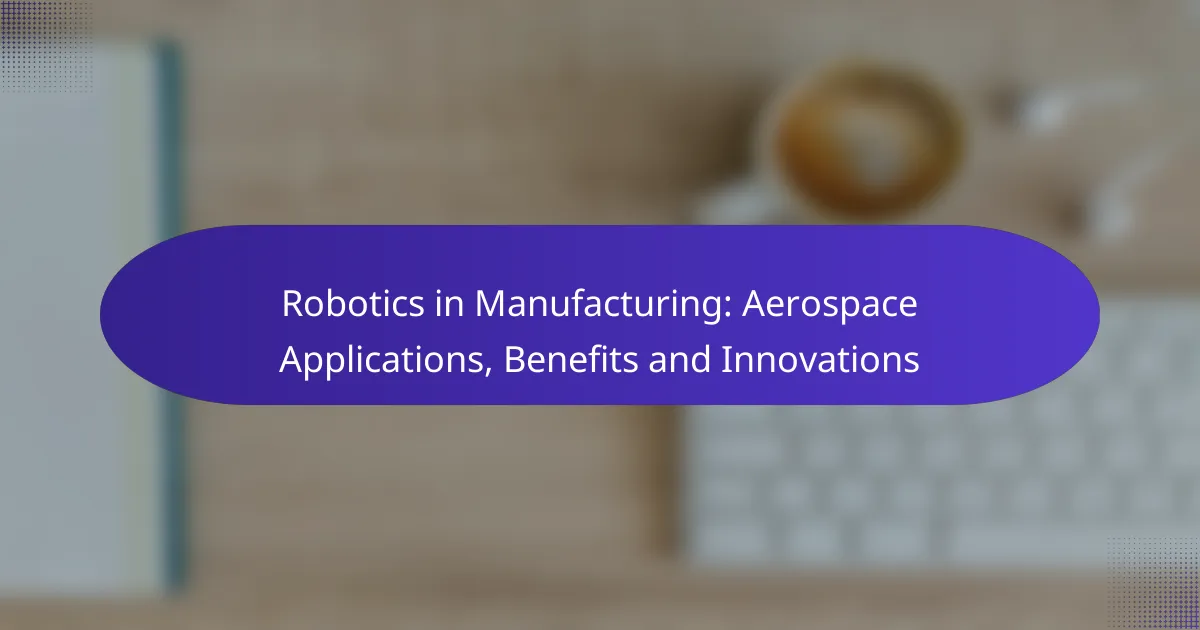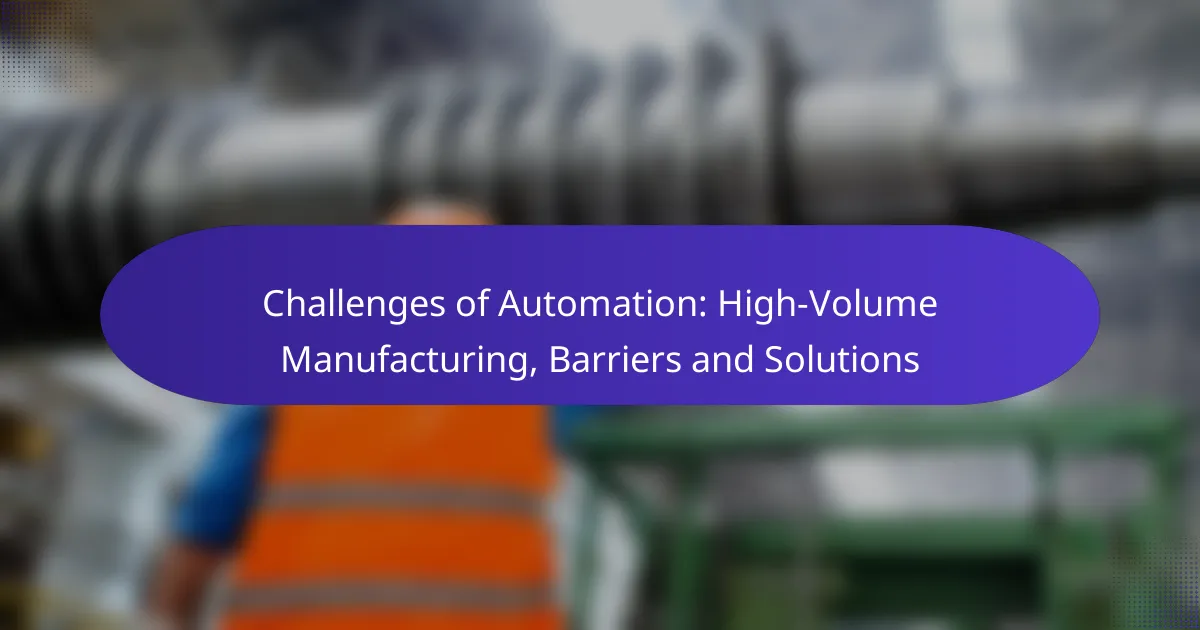Robotics are revolutionizing aerospace manufacturing by significantly improving efficiency, precision, and safety. By automating various processes, these advanced systems not only enhance product quality but also reduce operational costs, making them essential in modern aerospace operations.

How are robotics transforming aerospace manufacturing?
Robotics are significantly transforming aerospace manufacturing by enhancing efficiency, precision, and safety. These advanced systems automate various processes, leading to improved product quality and reduced operational costs.
Increased precision in assembly
Robotic systems in aerospace manufacturing provide exceptional precision in assembly tasks, which is crucial for meeting stringent industry standards. These robots can perform repetitive tasks with minimal variation, ensuring that components fit together perfectly.
For example, robotic arms equipped with advanced sensors can assemble intricate parts like fuselage sections and wing structures with accuracy measured in microns. This level of precision reduces the risk of defects and enhances overall product reliability.
Enhanced production speed
Robotics significantly enhance production speed in aerospace manufacturing by automating time-consuming tasks. Robots can operate continuously without fatigue, allowing for higher throughput compared to manual labor.
In many cases, robotic systems can complete assembly tasks in a fraction of the time it would take human workers, often reducing cycle times from hours to mere minutes. This acceleration helps manufacturers meet tight deadlines and respond quickly to market demands.
Reduction in labor costs
The integration of robotics in aerospace manufacturing leads to a substantial reduction in labor costs. By automating repetitive tasks, companies can minimize the need for a large workforce, allowing them to allocate resources more efficiently.
While the initial investment in robotic technology can be significant, the long-term savings on labor costs often justify the expense. Many manufacturers report reductions in labor costs by 20-40% after implementing robotic systems.
Improved safety standards
Robotics contribute to improved safety standards in aerospace manufacturing by taking over hazardous tasks that pose risks to human workers. Robots can handle heavy lifting, toxic materials, and operate in extreme environments, reducing workplace injuries.
Additionally, the use of robotics helps ensure compliance with safety regulations, as these systems can be programmed to follow strict operational protocols. This not only protects workers but also enhances the overall safety culture within manufacturing facilities.

What are the key benefits of robotics in aerospace manufacturing?
Robotics in aerospace manufacturing offers significant advantages, including enhanced precision, increased efficiency, and reduced operational costs. These benefits lead to improved product quality and faster production times, making robotics a vital component in modern aerospace operations.
Higher quality control
Robots enhance quality control in aerospace manufacturing by performing tasks with high precision and consistency. Automated systems can detect defects during production, ensuring that components meet stringent aerospace standards.
For instance, robotic inspection systems can analyze parts for dimensional accuracy and surface defects, reducing the likelihood of human error. This leads to fewer recalls and rework, ultimately saving time and costs.
Greater flexibility in production
Robotics provide greater flexibility in aerospace production by enabling quick changes to manufacturing processes. With programmable robots, manufacturers can easily adapt to different designs or production volumes without significant downtime.
This adaptability is crucial in the aerospace industry, where customizations are common. For example, a robotic system can switch from assembling one aircraft model to another in a matter of hours, accommodating varying customer demands.
Streamlined supply chain management
Robotics streamline supply chain management by automating inventory handling and logistics. Automated guided vehicles (AGVs) and robotic arms can efficiently transport materials and components within manufacturing facilities, reducing lead times.
Additionally, integrating robotics with inventory management systems allows for real-time tracking of parts and materials, minimizing stockouts and overstock situations. This efficiency is essential in the aerospace sector, where timely delivery of components is critical to maintaining production schedules.

Which companies are leading in aerospace robotics innovations?
Several companies are at the forefront of aerospace robotics innovations, significantly enhancing manufacturing efficiency and precision. Boeing, Airbus, and Lockheed Martin are notable leaders, each employing unique robotic technologies to streamline their production processes.
Boeing’s automated assembly lines
Boeing has implemented advanced automated assembly lines that utilize robotics for tasks such as fuselage assembly and wing construction. These systems enhance productivity by reducing assembly time and minimizing human error.
By integrating robotics into their assembly processes, Boeing can achieve higher consistency and quality in their aircraft production. The automation allows for faster turnaround times, which is crucial in meeting increasing demand in the aerospace sector.
Airbus’s use of collaborative robots
Airbus employs collaborative robots, or cobots, that work alongside human operators to enhance manufacturing efficiency. These robots assist in tasks like component assembly and heavy lifting, allowing workers to focus on more complex operations.
The integration of cobots has led to improved safety and productivity on the assembly line. Airbus has reported that these robots can operate in shared spaces without safety cages, making them versatile tools in their manufacturing environment.
Lockheed Martin’s robotic inspection systems
Lockheed Martin utilizes robotic inspection systems to ensure the quality and safety of their aerospace products. These systems employ advanced imaging and sensor technologies to detect defects and ensure compliance with stringent aerospace standards.
By automating the inspection process, Lockheed Martin can significantly reduce inspection times while increasing accuracy. This approach not only enhances product quality but also helps in maintaining regulatory compliance, which is critical in the aerospace industry.

What are the challenges of implementing robotics in aerospace?
Implementing robotics in aerospace presents several challenges, including high initial investment costs, integration with existing systems, and the need for workforce retraining. Addressing these issues is crucial for successful adoption and maximizing the benefits of automation.
High initial investment costs
The high initial investment costs associated with robotics in aerospace can be a significant barrier for many companies. This includes expenses for purchasing robotic systems, installation, and ongoing maintenance. Depending on the complexity and scale of the operation, these costs can range from tens of thousands to millions of dollars.
To mitigate these costs, companies can consider phased implementation, starting with less complex tasks that require fewer resources. Additionally, exploring leasing options or government grants can help offset the financial burden.
Integration with existing systems
Integrating robotics into existing aerospace manufacturing systems can be complex due to the need for compatibility with current technologies and processes. Companies must assess their existing workflows and determine how robotics can enhance efficiency without disrupting production. This often requires custom solutions and careful planning.
To facilitate smoother integration, it is advisable to conduct a thorough analysis of current systems and identify potential bottlenecks. Collaborating with technology providers who specialize in aerospace can also provide valuable insights and support during the integration process.
Workforce retraining needs
As robotics take on more tasks in aerospace manufacturing, there is a pressing need for workforce retraining. Employees must develop new skills to work alongside robotic systems, which can include programming, maintenance, and oversight of automated processes. This transition can be challenging, especially for a workforce accustomed to traditional methods.
To address retraining needs effectively, companies should invest in comprehensive training programs that focus on both technical skills and safety protocols. Encouraging a culture of continuous learning can help employees adapt to new technologies and enhance overall productivity in the workplace.

How to choose the right robotics solutions for aerospace?
Choosing the right robotics solutions for aerospace involves understanding specific production needs, evaluating technology options, and considering integration with existing systems. Focus on the tasks that need automation, the environment in which the robots will operate, and the expected return on investment.
Assessing production needs
Assessing production needs is the first step in selecting appropriate robotics solutions for aerospace. Identify the specific tasks that require automation, such as assembly, inspection, or material handling. Understanding the volume of production and the complexity of tasks will guide the selection process.
Consider the operational environment as well. Aerospace manufacturing often involves stringent quality standards and safety regulations, which may dictate the type of robotics technology suitable for your facility. For instance, cleanroom environments may require specialized robots that can operate without contaminating sensitive components.
Finally, evaluate the scalability of the robotics solutions. As production demands change, the ability to adapt or expand robotic capabilities can significantly impact long-term efficiency and cost-effectiveness. Aim for solutions that can be easily upgraded or integrated with new technologies as they emerge.



